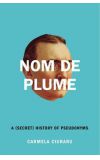
19 Jun 2011 05:05:03
Carmela Ciuraru's "Nom de Plume" deftly tells the stories of some of literature's most famous pen names by weaving in details about these secretive, often eccentric writers' lives and works to examine their decision to use pen names. From Lewis Carroll (born Charles Dodgson), to Mark Twain (Samuel Clemens) and Victoria Lucas (Sylvia Plath), one chapter is devoted to each with so much detail that the authors under discussion seem to become characters in Ciuraru's book.
Take the title of Plath's chapter: "She found sexual satisfaction in picking her nose."
For anyone who creates — writers, artists and performers — the book will enthrall. It's as much a meditation on the creative process as it is a tell-all about their names and the intrigue, branding or mind games that created them. Readers don't need to be familiar with all the writers. Some of the names aren't well-known to modern audiences, which Ciuraru acknowledges. But they'll still be able to appreciate the stories behind the story.
Ciuraru devotes pages to exploring the reasons for — and effects of — these other identities. She's done much research for this book, weaving in the authors' personal and public writings, along with those of their contemporaries.
The names can be an excuse, reason or outlet to create. The Bronte sisters — Anne, Charlotte and Emily, and Karen Blixen, wouldn't have been taken seriously — or even printed. So the male pen names of Acton, Currer and Ellis Bell, and Isak Dinesen, gave them a chance to be published.
Others, like Carroll, author of "Alice's Adventures in Wonderland," were well-established in their fields and wanted a pen name to separate their various selves.
Carroll, a "shy, eminent Oxford mathematician and lecturer, had created the nom de plume as a means of shelter from which he could let his imagination run wild," she explains.
He stuck to his pen name so much that he even asked a library at Oxford to delete all cross-references between his two names.

